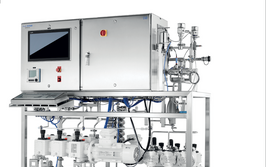
Mass spectrometry’s ever-increasing resolution has placed it at the forefront of glycan analysis. In this second article of a two-part series, we call upon the expertise of Jasna Peter-Katalinic – a forerunner in the field based at the University of Rijeka in Croatia – to understand the challenges, assess the breakthroughs, and discuss the impact on the biopharma market.
How did you get started in glycobiology?
I have been active in the field for about 35 years. My first glycan-centric project investigated the role of breastmilk oligosaccharides in the immunity of newborns. At that time, very little was known about the glycosylation of proteins beyond a few well-known examples. But it soon became apparent that most proteins are glycosylated during their lifecycle, and this plays a very important role in numerous physiological processes. Indeed, there are a whole range of rare congenital diseases associated with disordered glycosylation, many with severe symptoms.
What do you find so fascinating about the area?
You certainly have to be passionate to stay in an area for so long! When we started, many years ago, we had no precise idea where we were going. We were led by scientific curiosity and the opportunities that we could see in our exploratory experimental work. We formed collaborations with virologists, clinicians and many other life scientists. That crosstalk was inspiring. When I first presented our data at conferences, there was a big gap between people who developed instruments, physicists, chemists and so on. Fortunately, the gap has now largely closed. I have no trouble transmitting my enthusiasm for the subject to my colleagues and students – there is so much potential for the future.
How does glycosylation affect protein therapeutics?
Glycosylation is crucial to the activity of therapeutic monoclonal antibodies (mAbs) and there has been a lot of effort over the past 20 years to identify how glycosylation in the Fc portion of the mAb can influence activity, improve pharmacological efficiency and decrease toxicity. The question now is whether it is possible to replace glycans with other chemical groups that can fulfill the same function but are less complex in their molecular structure, making bioprocessing easier.
The classical IgG molecule is made up of heavy and light chains, linked by disulfide bridges. The two subunits are both glycosylated at a single natural glycosylation site - asparagine 297 - but the glycan group can consist of longer or shorter chains. Researchers are looking at whether the shorter chains are sufficient to keep the conformation of the antibody in its active form and, if so, whether they can be replaced by engineered molecules. We also need to know what other aspects are crucial to maintain conformation – shape, charge, polarity, hydration, and so on.
Engineering of glycosylation sites appears to hold great promise...
Absolutely. The lifetime of a mAb in the body when administrated as a drug is also crucial. If we add more glycosylation sites by molecular engineering, we could increase lifetime, and the dosage could be reduced. Reducing dosage is always a positive in terms of potential side effects and pricing.
Engineering of new glycosylation sites means introducing a specific sequence of amino acids – a consensus sequence – for N-glycosylation, which is achieved by molecular engineering; essentially, we alter the genetic code that forms the blueprint for the protein. Accurate analytical techniques are extremely important for quality control of engineered glycoproteins to confirm both the glycosylation site and the structure of the attached glycan.
How have mass spectrometry techniques for glycan analysis evolved?
In my view, mass spectrometry is the crucial method for quality control of glycoproteins. There are several approaches - some focused on high throughput analysis for monitoring profiles and some that are trying to clarify all structural aspects of these complex molecules.
Mass spectrometry is now in very good shape to answer most of the questions we have about glycosylation. Resolution has increased dramatically over the years and, put simply, higher resolution means better results. For example, Orbitrap technology allows you to collect fragment ions from the non-reducing/sugar end of the molecule and also from the residual peptides, so you can reconstruct the complete structure in a short timeframe.
What challenges remain?
With such a high level of instrumentation, good glyco-scientists can solve most structural problems involving N-glycans. The question of O-glycosylation is much more complex. There are no general enzyme systems to cleave O-glycans from the protein, so glycobiology researchers developed strategies such as the SimpleCell method, in which cell lines are engineered to generate only the core/truncated version of the O-glycan. Such strategies allow discovery of all O-glycosylation sites of a protein (and there can be more than 100).
There is also an unmet need in analytical software. There is no software currently in use that can take the raw data from mass spectrometry and interpret de-novo data. Now that mAbs are such a big segment of the market, and software can be more easily adapted to different instruments, this looks likely to change in the near future.
What are your main career highlights?
Several times, I’ve been involved with the inception of an entirely new area of research. Early in my career, I remember experiments that led to the discovery of a new type of modification on an embryonic antigen, in collaboration with an eminent leader in glycobiology research – Professor Saul Roseman – which led to a host of new theories. Another highlight was discovering new types of sialyation found in starfish (sea stars) that totally changed the biochemical theories of that time – they literally had to re-write chapters of some biochemistry textbooks. Some of my most cited papers are those where, in collaboration with other groups, we defined some of the key sites for glycoengineering – O-mannosylation and O-fucosylation sites in large molecules. It was like finding a needle in a haystack, but it is a very satisfying to know that we were able to provide a solid molecular basis for functional studies.
However, I consider my greatest achievement to be the scientific and professional success of my graduate students, some of whom are now professors at their own universities or laboratory leaders in other institutions; many still work on topics they were introduced to in my lab.
What are you working on right now?
As well as N- and O-linked glycans, there are another type of sugars which intrigue me – glycosaminoglycans. They are major ingredients of the extracellular matrix and are involved in many human diseases, from rare inherited metabolic disorders like mucopolysaccharidosis to common diseases of old age like osteoarthritis. Researchers are now looking at potential drugs made up of sulfated oligosaccharides, which is a tough analytical challenge – if you are not careful, you can easily lose the sulfate during ionization or fragmentation. In addition, we do not know what size of oligosaccharides are functional. By combining capillary electrophoresis, chromatography and mass spectrometry, we hope to find the answers.
At the moment, the Department of Biotechnology at the University of Rijeka is in the process of implementing new equipment, so that is taking up a lot of my attention. I expect to establish several options for glycosylation analysis, including an ion mobility mass spectrometer and simpler machines for routine analysis. We hope eventually to add the highest resolution mass spectrometry machines – Orbitraps (Thermo Scientific™ Orbitrap™ based high resolution accurate mass spectrometers) and ion cyclotron resonance (ICR) systems – to maintain our position as the best-equipped laboratory for mass spectrometry in Croatia.
How can we push the field forward?
Large-scale collaboration is crucial for integrating our knowledge, from math and physics to biology and medicine. Our group is looking for collaborations in medicinal chemistry and drug development, so if any readers are interested, please get in touch!

A professor in the Department of Biotechnology at the University of Rijeka, Croatia.


















